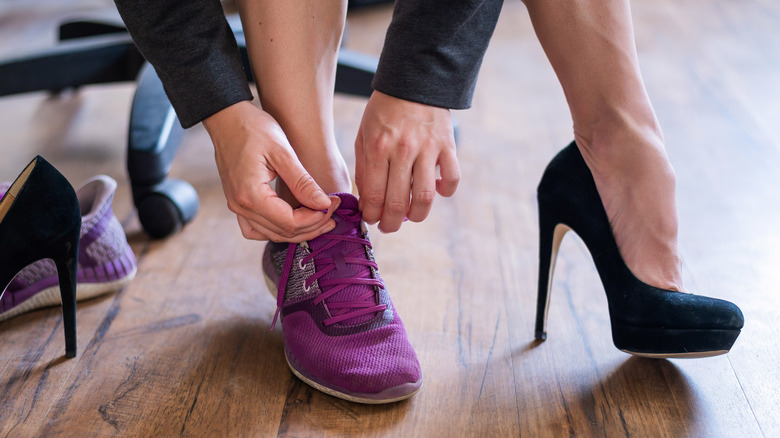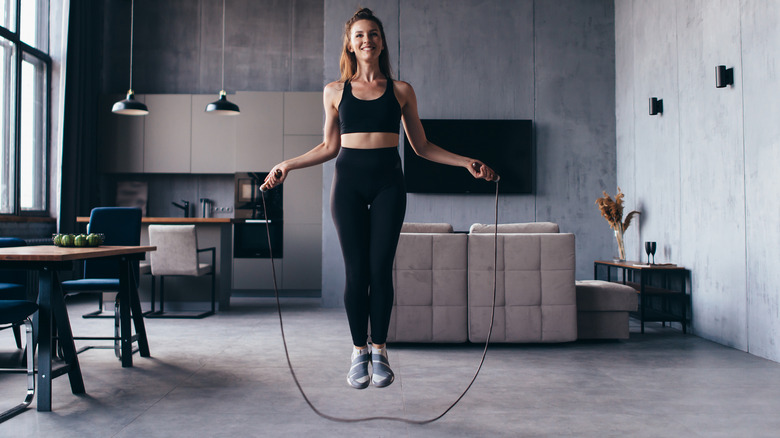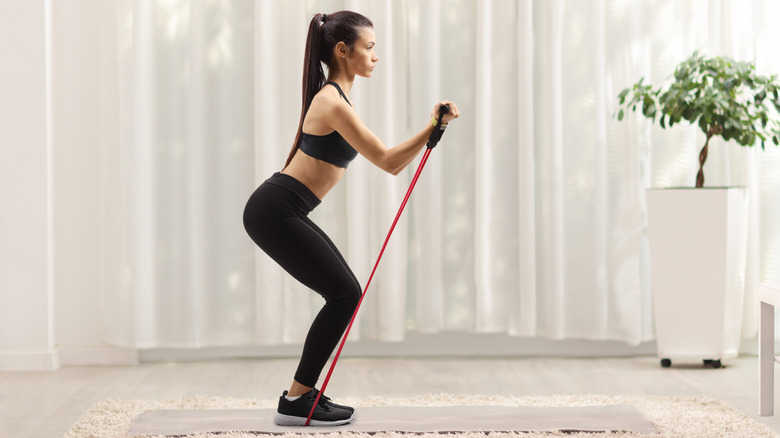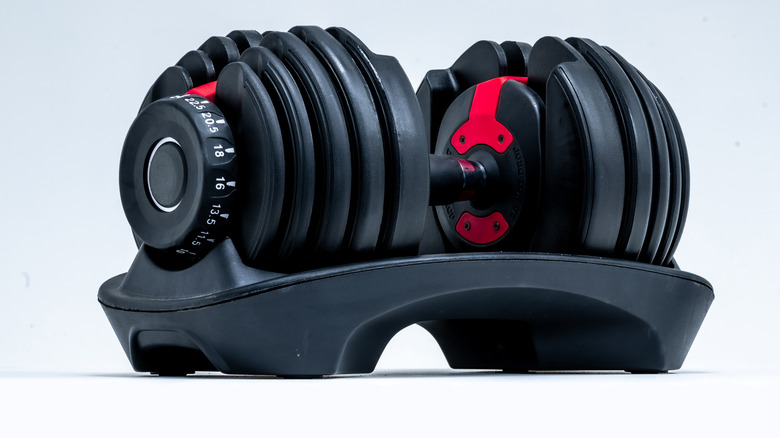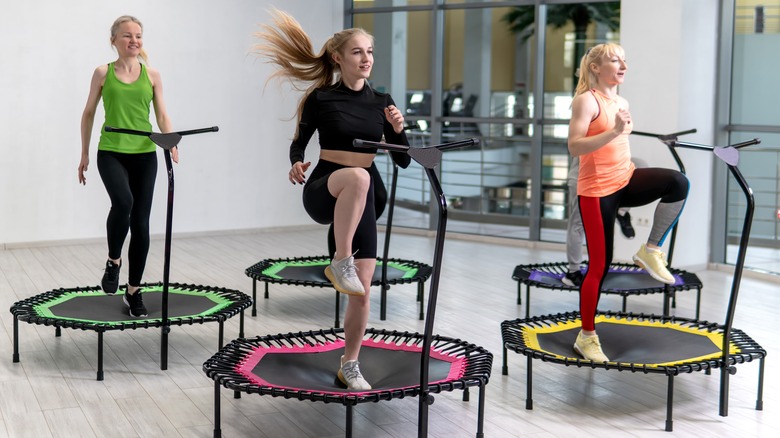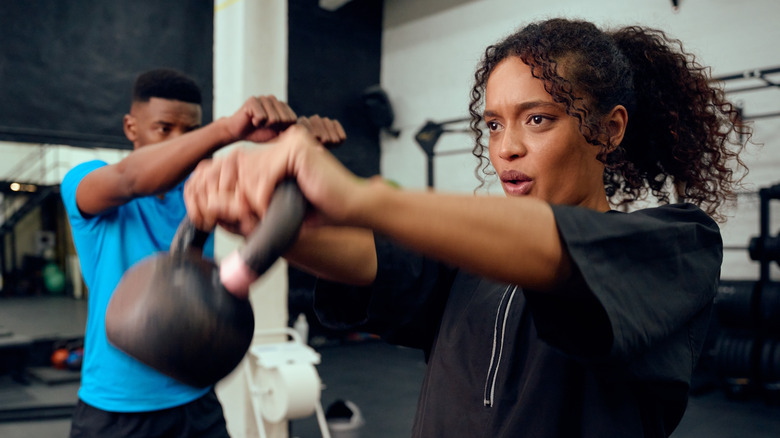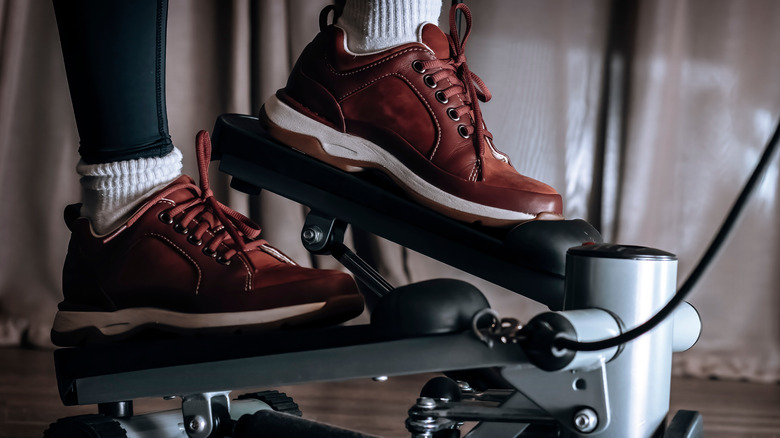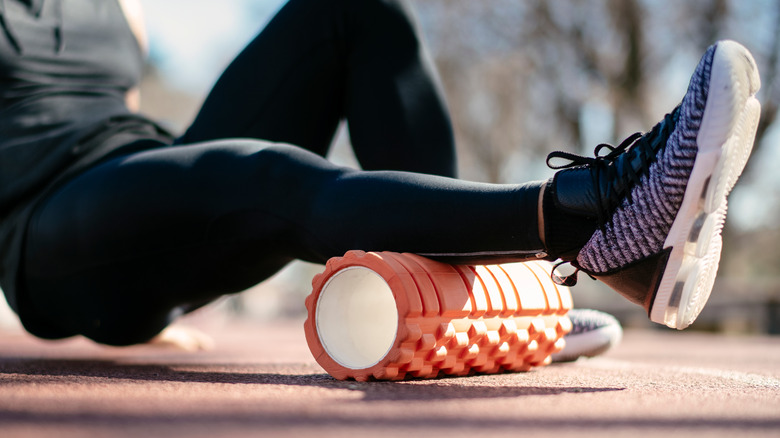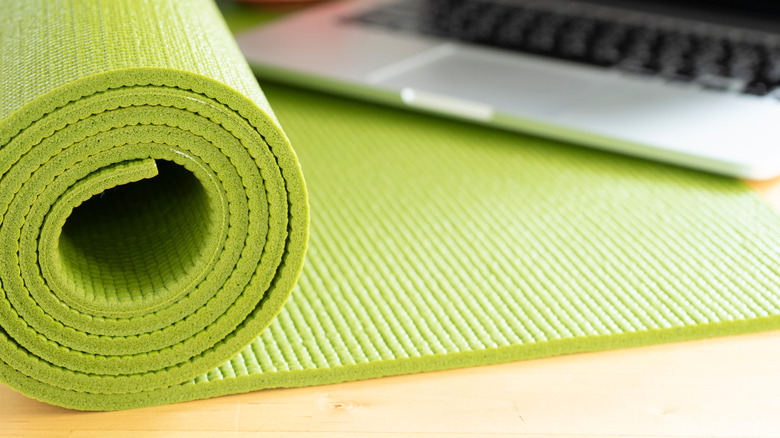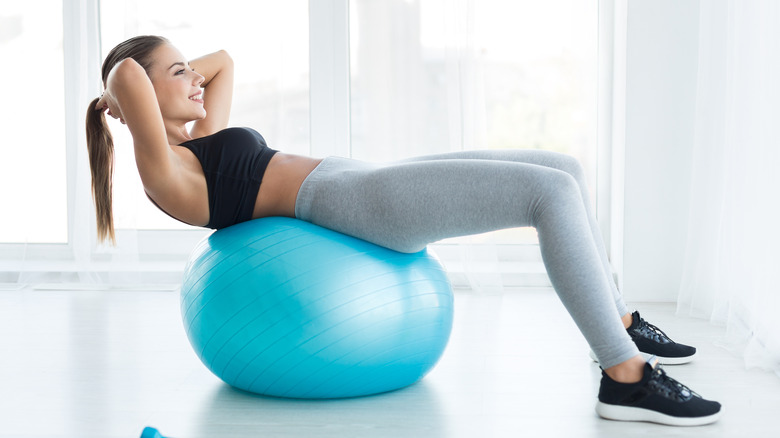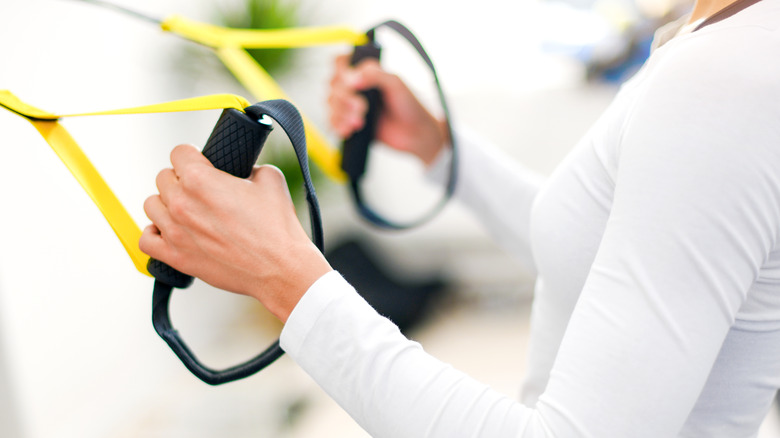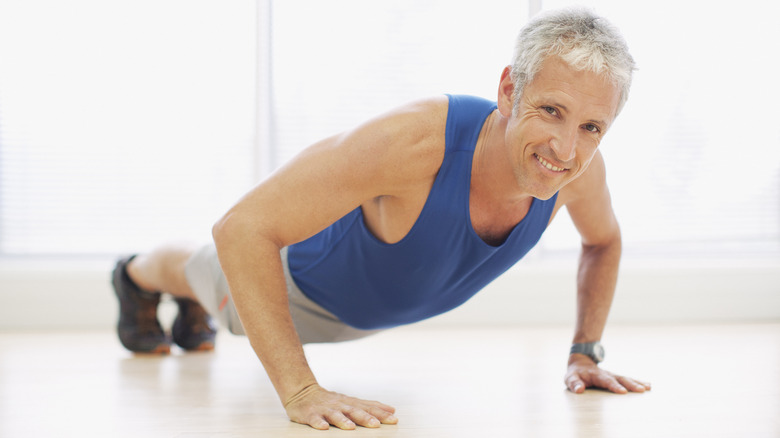Simple Fitness Equipment You Can Keep At Your Desk
Saving time and money and improving your health go a long way toward reducing stress levels and increasing your quality of life. One way to achieve all three of these goals is to fit your workout in throughout your workday, instead of saving it for before or after work when you're likely to skip it.
Working out for 10 minutes three times a day can be as effective as one 30-minute workout (via Smokefree.gov). Taking breaks during your workday can also help make you more productive and lessen the risks associated with sitting for long periods, which include a greater risk of obesity, high blood pressure, high blood sugar, high cholesterol, and increased abdominal fat (via BMC Public Health and Mayo Clinic).
If you don't have time to get to the gym, you can bring the gym to your office by investing in some portable, inexpensive exercise equipment compact enough to be stored under your desk. Whenever you have a break, you can easily get in 10 minutes of moderate-intensity exercise that can strengthen your cardiovascular system, help you manage your weight, and build strength.
Jump rope
Most kids learn how to jump rope growing up, but toss aside the activity as child's play during adulthood. That's a mistake. With a single piece of cord, you can get a full-body workout: As you jump, your calves, thighs, glutes, abs, arms, and shoulders activate, building muscular strength, endurance, and power. Jumping rope is a form of plyometric training, also known as jump training. Many athletes utilize plyometric training; research shows that it can boost jump height, sprinting ability, and agility (via the Journal of Human Kinetics).
Jumping rope can also strengthen your bones and your heart and lungs. If burning calories is your goal, just 15 minutes of jumping rope can burn as many as 300 calories depending on your weight, fitness level, speed and other factors (via Omni Calculator).
If you learned jumping rope as a child, you'll be able to pick it back up quickly. Otherwise, it may take you a little longer to get the hang of it. When you're just starting out, it's a good idea to take it slow. Because the main motion of jumping rope in the lower body is pushing off the forefoot, the calves work especially hard. If you do too much too soon, you may experience very sore calves the next day. Start out with five sets of 30 seconds of jumping rope, with 30 seconds of rest in between. Gradually increase the amount of time you spend jumping and decrease the amount of rest time.
Resistance bands
Resistance bands are a perfectly portable way to build total-body strength, whether you're at the gym or at the office. As the name implies, these bands work by forcing your muscles to work against resistance, therefore strengthening them. Made out of a rubbery material, the bands stretch and contract. They're available in different shapes — either straight with handles on either end or loops — and levels of resistance. Generally, the thicker the band, the greater the amount of resistance. If you purchase a set, they'll often be color-coded to tell you what level of resistance each band provides.
You might be wondering how a workout with these compact bands stacks up to traditional weightlifting. According to a 2019 study, they are just good at promoting strength gains as the conventional method. Many of the same exercises performed with free weights and weight machines can be performed with bands. For example, you can do shoulder presses by standing on the middle of a long band, holding the handles at shoulder height, then pressing your arms up overhead. You can do a chest press by wrapping the band around your back, holding onto the handles and pressing your arms out in front of you. You can also add resistance to squats with a heavier band. Hold a handle in each hand, stand on the band with your feet hip-distance apart, squat down, and then stand back up.
Adjustable dumbbell set
If you prefer free weights to bands, you can store those in your office, too, without having to purchase a big, bulky set. An adjustable dumbbell looks like a standard dumbbell, but you change the resistance generally by turning a dial or adding or removing small weight plates. A typical adjustable dumbbell can provide between 5 and 50 pounds of resistance (via WebMD).
As with any type of resistance training, using adjustable dumbbells can help you build strength and muscle mass. Using free weights is also an effective way to improve your balance. If you're looking to maintain or lose weight, strength training is an important part of your exercise program. Although weight training doesn't burn a lot of calories while you're doing it, it helps you build lean muscle mass and improve your body composition. Having more muscle mass increases your resting metabolic rate, which helps you burn more calories all day long.
You can do any type of exercise with adjustable dumbbells that you can do with regular dumbbells. A quick upper body workout for the office includes single-arm rows, chest presses, military presses, and triceps extensions. If you're a beginner, do one to three sets of 12 to 20 repetitions for each exercise. Use a weight that allows you to maintain proper form throughout the exercise, but provides enough resistance to make the last reps of each set very challenging. If you're more advanced, you can do more sets with lower repetitions and a heavier weight.
Mini-trampoline
Bouncing on a trampoline while also getting a workout in may sound too good to be true, but it's not. Called "rebounding," jumping on a mini-trampoline offers a variety of benefits. Jumping activates muscles throughout your body, including your legs, glutes, and core muscles. Aside from building bone strength, it improves balance, which can reduce your risk of falls as you age. Falls among the elderly are responsible for over 95% of hip fractures, per the Centers for Disease Control and Prevention.
While a mini-trampoline can't exactly fit under the average-size desk, it can be easily stored in a corner or up against a wall. When you get a break, you can simply hop on and jump for 10 minutes and get your heart rate up. According to Health Research Funding, the average weight person burns 37 calories in 10 minutes of rebounding, depending on the type and intensity of rebounding you're doing. More advanced and more challenging rebounding workouts will burn more calories.
There are many more ways to work out on a mini-trampoline besides just jumping up and down. You can jump side to side and front to back, which will activate different muscles in your legs and core. You can jump on one foot to increase the challenge to your muscles and your balance. You can also combine rebounding with bodyweight exercises such as squats, pushups, and lunges for a challenging full-body workout you can do without leaving your office.
Kettlebells
Kettlebells are becoming more and more popular in gyms and fitness classes these days, and they're also a great way to get a workout in your office. Shaped like a cannonball with a flat bottom and a handle on top, kettlebells originated in Russia more than three centuries ago (via Kettlebells USA). They're compact enough to fit under your desk and can be used in a multitude of ways to build full-body strength, power, agility, and cardiovascular endurance, as well as improve mobility, flexibility, and joint health.
The best part is that a kettlebell workout is time efficient. According to a study by the American Council on Exercise, it's possible to burn 20 calories per minute or 400 calories in a 20-minute workout. That's more than the average person burns running at a pace of 5 miles per hour in 60 minutes (via Harvard Health).
The classic kettlebell exercise is the swing. To do it, stand with your feet shoulder-distance apart and hold the bell with both hands. Keep your back straight as you bend your knees and send your hips down and back. Bring the kettlebell back between your legs, then forcefully lift your chest, extend through your knees, and swing the kettlebell in front of you. You can do many other exercises such as goblet squats, thrusters, shoulder presses, and bent-over rows. Choose a few exercises and do them in a circuit in your office to get your heart pumping and your muscles burning.
Under-desk stepper/elliptical/bike
If your office isn't big enough to fit a full-size exercise machine, don't worry. You can get mini versions of stationary bikes, ellipticals, and stair steppers that slide right under your desk. Under-the-desk cardio equipment won't give you quite as good a workout as the full-size version, but it will help you increase your activity level and work more movement into your day. Many people with desk jobs live a sedentary lifestyle, which can be deleterious for one's health. According to the World Health Organization, lack of physical activity increases your risk of death from all causes and doubles your risk of many chronic diseases and mental disorders.
Whichever machine you choose, you can use it standing up or sitting down. During a video meeting, while you're on a client call, or entering data into a spreadsheet, you can pedal your way to better health. For greater benefits, increase the intensity of your workout. Standing up while exercising will increase the calorie burn (via MedlinePlus). You'll also challenge your muscles more and improve your balance. The harder you work out, the more benefits you'll gain.
Foam roller
Maintaining your flexibility and mobility are an important part of a well-rounded workout routine, and a foam roller is a compact and effective tool to help you do that. Foam rollers are cylinder-shaped pieces of dense foam or rubber. They are often smooth, but sometimes they'll feature a textured or knobby surface. Which one you choose depends on your goals and your experience level. Generally, in the beginning it's better to choose a lower-density roller with a smooth surface (via National Academy of Sports Medicine).
Research is mixed on exactly how foam rolling works. But the general theory is that using the foam roller to place pressure on the muscle tissues helps relax the nervous system, which in turn allows the muscles to relax and lengthen. Foam rolling may also help release muscle knots and adhesions that can impede mobility and flexibility and cause pain.
Here's how to get started: Get down on the floor with your roller, ideally on a yoga mat or carpet. Position your body on the foam roller on a muscle you want to work on releasing — your hamstrings, for example. Using your hands to support some of your body weight, but allowing the weight of your body to create pressure on the muscle, slowly roll the length of the muscle. If you find a particularly tender spot, hold there for about 30 to 60 seconds. To increase the relaxation effect, try taking slow, deep breaths as you roll.
Yoga mat
Yoga is one of the best portable full-body workouts, providing myriad benefits for your physical and mental health. A regular yoga practice can improve flexibility, strength, and muscle tone; increase energy; help you maintain or lose weight; improve cardiovascular and circulatory health and athletic performance; and prevent injury. Per research, a regular yoga practice can also help reduce symptoms of anxiety and depression. A 2013 study showed that yoga with or without medication reduced depression better than medication alone. All you need to reap the benefits is a yoga mat that you can easily roll up and stow under your desk.
Getting started with yoga can be intimidating, but it doesn't have to be. Sun salutations are an easy introduction to a yoga practice. It's a quick opening sequence that warms up the body, builds heat, and flexibility. Start in a standing position with your feet together and arms at your sides. Inhale as you raise your arms overhead, then exhale as you fold forward. Inhale and lift your torso with a flat back so it's parallel to the ground, then exhale to fold forward again. Step your feet back to a pushup position, then lower your body to the ground. Inhale to upward dog, then press back to downward dog. Step your feet forward to the top of the mat, inhale to a flat back, exhale and fold forward again, then inhale to stand up raising your arms overhead, then exhale to your starting position. Repeat several times.
Chair yoga
You don't even need a mat to reap the benefits of yoga; you can do some easy poses in your chair at your desk. Chair yoga is a great option for people who have problems with standing or balance. You can also do some chair yoga poses while you're on a call with a client, or take a five-minute break to do some stretches if you don't have time to get up and roll out your mat.
Start with neck rolls. Sit up tall in your chair, and lower your chin to your chest. Slowly roll your neck to the right, bringing your ear to your right shoulder. Then, drop your head back to stretch the front of the neck. Next, roll your head around to the left, bringing your left ear to your left shoulder. Finish by rolling your neck forward again with your chin to your chest. Repeat several times, then switch directions.
Build flexibility and mobility in your back with cat-cow pose. Sit up tall in your chair and place your hands on your knees. Inhale as you lift your chest up and arch your back, then exhale as you round your spine. Continue to alternate between these positions.
Lastly, release tension in your spine with a spinal twist. Sit up tall and turn your torso to the right. Place both hands on the right arm of your chair and gently twist your body further. Come back to center and repeat on the other side.
Stability ball
Stability balls are large, round inflatables with a variety of exercise applications. Some people even use stability balls as desk chairs to encourage better sitting posture and reduce low back pain. However, research has shown that using a stability ball as a desk chair could actually increase back pain (via University of Waterloo). Regardless, it's still a great, compact tool for an office workout.
One of the benefits of stability balls is that they provide an unstable surface that challenges your small stabilizer muscles and can increase the challenge of traditional exercises (both bodyweight and weighted). You can work your legs with stability ball hamstring curls and squats. Lie on the ground and position the ball near your feet. Place your heels on the ball, lift your hips off the ground, and slowly curl the ball in towards your buttocks. Slowly roll back out, then repeat. To do stability ball squats, position the ball between your lower back and the wall. With your feet hip-distance apart, roll the ball along your back as you bend your knees and sink into a squat. Roll back up and repeat.
Stability balls can also increase the challenge of a regular pushup by testing your balance and core strength. Place your hands on the ball about shoulder-width apart. Contract your core muscles and lower your chest down to the ball, bending your elbows so they point back behind you. Press back up again and repeat.
Suspension trainer
A suspension trainer is a long strap with handles on either side and anchored in the middle to the ceiling. You can find versions that don't require permanent installation and instead anchor to a door frame.
You can do a variety of exercises with a suspension trainer to target every muscle in your body. To do a row targeting the muscles of the upper back, hold the handles, step your feet forward and extend your arms, so that your body is in one straight line at about a 60-degree angle. Bend your elbows as you pull your body up, so that the handles come on either side of your chest. You can make the exercise harder by stepping your feet out farther, or make it easier by stepping your feet in.
To do chest presses, reverse your body position, stepping your feet back behind you. Start in a pushup position with your arms extended, then slowly lower your chest towards the handles. Keep your core muscles contracted and press back up to the starting position. You can increase the challenge by walking your feet back, or decrease it by walking your feet forward.
You can do a variety of other exercises, including pullups, hamstring curls, triceps extensions, chest flys, biceps curls, deltoid flys, lunges, and squats.
No equipment needed
The truth is, you don't need any equipment at all to get a quick anytime, anywhere full-body strength and cardiovascular workout. Bodyweight exercises are easy and effective, and build functional strength that can improve the ease with which you do everyday activities (via Harvard Health).
To get a cardiovascular workout, try jumping jacks, jogging in place, high knees, mountain climbers, burpees, air jump rope, and skater slides. For a strength workout, do air squats, lunges, pushups, planks, glute bridges, tricep dips, step-ups, and crunches.
Organize your workout in a circuit, alternating cardio moves with strength moves to keep your heart rate high throughout your workout for maximum calorie burn. Set a timer and do each exercise for 30 seconds, then switch to the next exercise without a rest break. At the end of the round, take 60 seconds to catch your breath, then do another round. Aim for two to five rounds, depending on your fitness level and the number of exercises you include in your workout.

